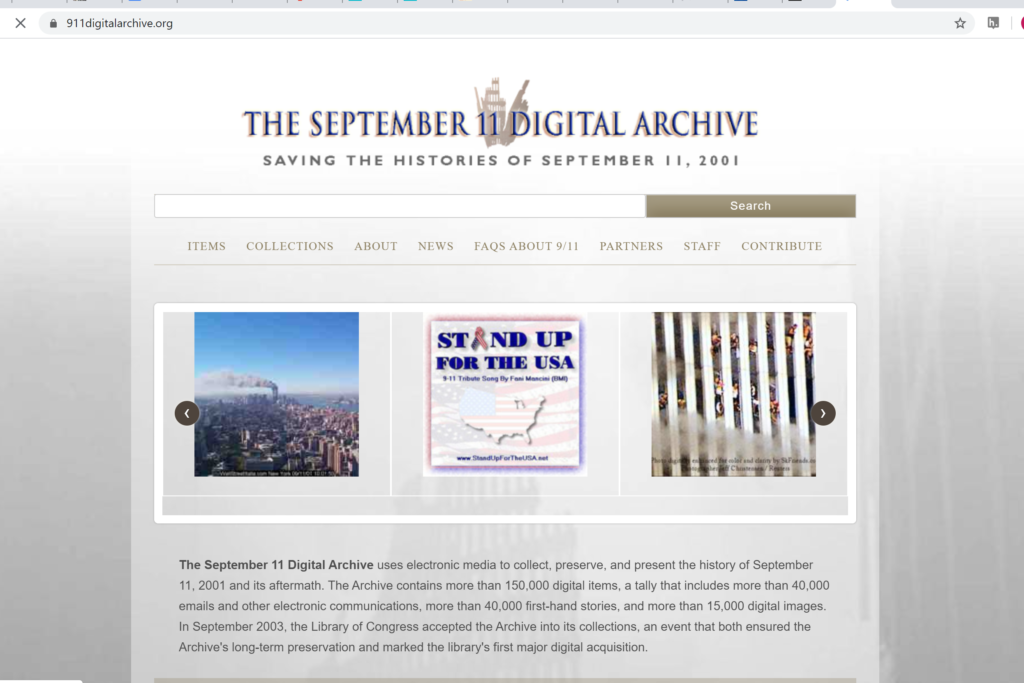The September 11 Digital Archive, https://911digitalarchive.org/, Roy Rosenzweig Center for History and New Media and American Social History Project/Center for Media and Learning, https://911digitalarchive.org/about , consulted on February 16, 2020
The Library of Congress inaugurated the 9/11 Digital Archive in 2003. The archive is a virtual smorgasbord of materials related to the events of September 11, 2001. It contains thousands of items: newspaper articles from before and after the event, pictures taken by families in front of the Twin Towers just days before the disaster, poems written in honor of first responders and fire fighters, personal compositions written by people who were effected by the events of 9/11, oral histories, news clips, and much more. In total there are over seventy thousand items in the archive. The archive is not purely scholarly, but rather acts as more of a digital home for the memories of those who experienced 9/11. As their about page states, ” The September 11 Digital Archive uses electronic media to collect, preserve, and present the history of the September 11, 2001 attacks in New York, Virginia, and Pennsylvania and the public responses to them. “
The design of the archive is simple, but it works. It is divided into different collections (for example the Anniversary Collections or the Audio Collection). Also, a visitor to the archive can browse the items without having to chose a particular collection; all text submissions, oral histories, videos clips, and photos will be mixed together, instead of being separated into different collections. Interestingly, the archive also has links to additional collections complied from outside sources, and a crowd sourced collection open for visitors to the digital archive to add their own memories of 9/11. Browsing through this collection, a visitor finds memories that are only a few sentences long, and these are usually not composed by those who participated in the events first hand, but instead by those who experienced the events from their T.V. screens or even half way across the world. This is significant, as it reminds the visitor of how far reaching 9/11 was for the American people. The archive also has the usual archive search option and an about page describing how the archive was compiled as well as a staff page thanking the team that put together and currently oversees the archive.
The audience for the 9/11 digital archive is extremely diverse. It is meant for all people who remember the events of 9/11. It is not merely limited to those who participated in the events first hand. This is evidenced by the sheer number of items in the archive, as well as the different kinds of submissions; many of which are written by or submitted by ordinary Americans who experienced 9/1 1. These submissions, as noted above, range from oral submissions to simple text submissions. However, all the submissions offer insight into how Americans viewed 9/11, both then and now.
The archive, as mentioned before, has a simple layout. However, it has a unique history in that it was the first digital archive to be accepted into the Library of Congress, thus helping to insure that it would be preserved for posterity. In 2011, the archive was moved to Omeka, where the website was relaunched on a more stable platform. This fathered the project team’s goal of preserving the archive and these memories forever.
The original team that put together the 9/11 Digital Archive is made up mostly of archive and meta data experts from George Mason University’s Center for History and New Media as well as historians, investigators, programmers, and web designers from City University of New York Graduate Center and John Jay College, City of New York University. Today, the project is overseen by a team from the Roy Rosenzweig Center for History and New Media. The 9/11 digital archive has also attracted many influential partners such as the Library of Congress and The Smithsonian Institute which have helped to preserve and grow the archive. Additionally, visitors to the archive can make their own contributions thus adding their voices and their stories to the it..
The 9/11 Digital Archive is a simple, well organized, and meaningful archive that successfully catalogs the emotional turmoil felt by a nation and its people during one of the most tragic days in its history.

